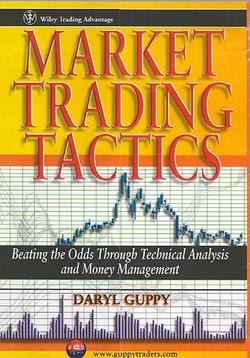Читать книгу Market Trading Tactics - Guppy Daryl - Страница 6
На сайте Литреса книга снята с продажи.
Part I
JOINING THE RUSH
Chapter 1
Trading with the Balance of Probability
PICTURE PERFECT
ОглавлениеThe Antarctic has weird snow shapes sculpted by the wind, the desert sun-blasted rocks. Our landscape resembles that of a little known Disney educational cartoon on maths. It did little to improve arithmetic skills, but its enduring image is of a man in a landscape of distorted numbers, towering 7s and 5s, rather like a Sesame street nightmare. The market jungle replaces vegetation with elegant price bars, thickets of candlesticks and clumps of moving averages against bluffs of charting.
Charts affront many traditional market players, from company directors, to brokerages and brokers, to moms and pops. They appear to devalue their hard-won research and knowledge by suggesting prices can be understood independently from the fundamentals of the underlying company or economy.
Some chartists confirm this divide by relying almost exclusively on obscure number relationships, often expressed as cycles and recurrent angles. Some fundamental traders add their bit to the division by emphasizing that only detailed financial understanding of the company’s books, with a dash of informed knowledge about company secrets, can allow the trader to take profitable positions in the market.
The truth lies somewhere in between. I rely primarily on charting and technical analysis as the basis of my trading decisions. This horrifies one of my brokers, but he has learnt to live with it. I use these methods to identify my trading opportunities. You may use other methods, but when it comes to assessing the trade we need information that only the chart can provide. It is beyond question that an ability to read a price chart will improve your trading.
A judicious mix of both disciplines makes for better trading. A price chart conveys very specific information in the same way a balance sheet reveals very specific financial information. Both displays – graphic and numerical – sometimes reveal more than their authors intended. Both displays are easily misunderstood.
No matter how you research, and finally reach, a trading decision you must eventually analyze and assess the trade financially. When the trade is entered, the open position must be managed to achieve financial objectives. The price chart, not the newspaper, gives you the basic information needed to undertake this planning process. Later we will look in detail at these procedures.
For now it is sufficient to understand that neither the entry nor the exit from a trade is determined by changing price-earnings (PE) ratios, by management structures, by product litigation, profit forecasts or food poisoning scares. These certainly are events that trigger a decision to buy or sell, but they do not set the price the trader receives. Better traders make an exit based on the most recent price activity. Except in apocalyptic events, such as October 1987, few market professionals unload stock at any price. Instead they use current price activity to make an informed decision about the best possible exit price. Private traders emulate this and the chart, as a record of prices, is an indispensable trading tool.
Please remember, when a chart is used as some type of computerized ouija board it is just as accurate, and useful, as ouija board forecasts.
Let us very briefly consider the types of information conveyed in a price chart and what it does, and does not, tell us about the security we are considering. We need to decide if the bulge is fat profit, or dangerous flab.
